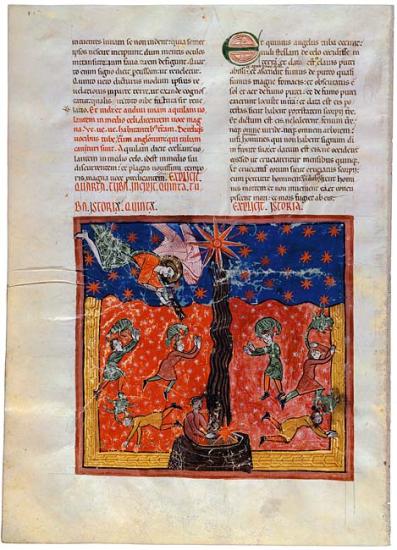
Fifth Trumpet: The Star Falling Into The Bottomless Pit And The Plague Of Locusts
Beatus of Liébana
Las Huelgas Apocalypse
Purchased by Pierpont Morgan, 1910
And the fifth angel sounded the trumpet. And I saw upon the earth a star that had fallen from heaven, and the key to the well of the abyss was given to him. And he opened the well of the abyss. And the smoke of the well ascended, like the smoke of a great furnace. And the sun and the air were obscured by the smoke of the well. And locusts went forth from the smoke of the well into the earth. And power was given to them, like the power that the scorpions of the earth have. And it was commanded that they must not harm the plants of the earth, nor anything green, nor any tree, but only those men who do not have the Seal of God upon their foreheads. And they were not to kill them, but torture them for five months. In those days, men will seek death but not find it; they will desire to die, and death will flee from them. (Rev. 9:1–6)
The artist depicted the falling star twice, in the sky and in the pit. According to Beatus, the man in the pit with the key and the star relate to fallen sinners who have opened their hearts to Satan.
The Apocalypse, or Book of Revelation, is not only the last Book of the New Testament, but its most difficult, puzzling, and terrifying. It provided challenges to medieval illustrators and was the source for a number of popular images, such as Christ in Majesty, the Adoration of the Lamb, and the Madonna of the Apocalypse and contributed to the widespread use of the Evangelists' symbols.
Selected images from Apocalypse Then: Medieval Illuminations from the Morgan, an exhibition held at the Morgan are presented here. The exhibition celebrates the completion of a facsimile of the Morgan's Las Huelgas Apocalypse—the latest dated (1220) and largest surviving manuscript of a Spanish tradition of illuminated commentaries on the Apocalypse by the monk Beatus of Liébana. The series of manuscripts constitutes Spain's most important contribution to medieval manuscript illumination.
The Las Huelgas Apocalypse contains three sections: the prefatory cycle, the Apocalypse, and the Book of Daniel.
In addition to forty-nine images from the Las Huelgas Apocalypse, six images from other manuscripts in the Morgan's collections, including the earliest Beatus painted by Maius and one by the Master of the Berry Apocalypse, are in this presentation.
